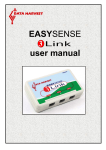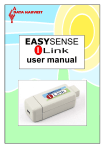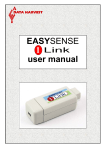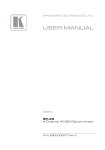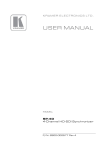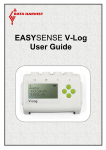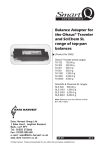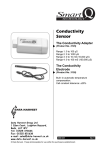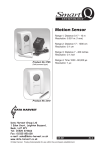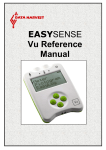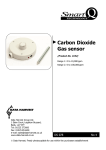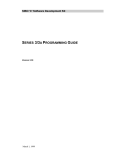Download EASYSENSE user manual
Transcript
EASYSENSE 3 Link user manual EASYSENSE 3Link DO229 (1) CONTENTS What is supplied? ................................................................................................................ 2 Using EASYSENSE 3Link for the first time ...................................................................... 3 Using EASYSENSE 3Link with the computer after initial setup....................................... 4 The EASYSENSE software overview ................................................................................ 4 Using Smart Q Sensors ....................................................................................................... 6 Technical information ......................................................................................................... 8 Updating EASYSENSE 3Links firmware........................................................................... 9 Warranty............................................................................................................................ 10 Copyright: all rights reserved. This manual may be copied for use within the premises of the Licensee on condition that it is not loaned, sold or used outside the Licensee's premises. Data Harvest's policy is to continually improve products and services, so we reserve the right to make changes without notice. It is acknowledged that there may be errors or omissions in this publication for which responsibility cannot be assumed. No liability will be accepted for loss or damage resulting from use of information contained in this manual or from uses as described. Document No: DO229 (Issue 1) What is supplied? The EASYSENSE software with Quick Start Guide The EASYSENSE 3Link interface Three Smart Q sensor leads (2 long and 1 short) © Data Harvest Group Ltd. A standard A to standard B USB cable 2 EASYSENSE 3Link DO229 (1) What else is required? Smart Q Sensors for capturing data. Please visit our website (www.data-harvest.co.uk) or contact your supplier for an up-to-date list of Smart Q Sensors. Using EASYSENSE 3Link for the first time EASYSENSE 3Link is used connected to the USB port on a computer. The data from any Smart Q Sensor connected to EASYSENSE 3Link will be transmitted immediately to the computer and displayed on the computer’s screen using the applications in the EASYSENSE software. Note: Do not connect EASYSENSE 3Link to the USB port until after the EASYSENSE software has been installed. Step 1: Install the EASYSENSE software, if it is not already on your computer. For details of how to install and operate this program, please refer to the instructions provided with the EASYSENSE software. Make sure EASYSENSE 3Link is not connected to the USB port during this installation. EASYSENSE 3Link requires version 2.8 or above of the EASYSENSE software. (The version number can be verified in About from the Help menu). Step 2: Install the EASYSENSE 3Link USB drivers. • Connect the ‘square’ USB plug of the USB cable to the USB input on the back of EASYSENSE 3Link. • Connect the ‘flat’’ USB plug to a USB port on your computer. • Windows will automatically detect a new device and install the drivers. Step 3: Connect the Smart Q Sensors being used to the sensor inputs on EASYSENSE 3Link. See page 7. Note: If digital sensors are to be used for Timing operations they must be connected to the inputs labelled 1:A and 2:B. Step 4: Open the EASYSENSE software program. © Data Harvest Group Ltd. 3 EASYSENSE 3Link DO229 (1) The first time the EASYSENSE program opens a ‘Select Program Level’ window will automatically open. Select a suitable user’s level. • Level 1 is aimed at ‘start’ level (e.g. up to 9 years old). • Level 2 is aimed at ‘mid’ level (e.g. 9 – 15 years old). • Level 3 is aimed at ‘exam’ level (e.g.15 years plus). Note: The program level can be altered at anytime using the Level icon once a logging option has been opened. Step 5: An Interface option window will open. 1. Select the Interface as EasySense Range. 2. Select the method of connection as USB port. 3. If you use different interfaces or methods of connection, tick the ‘Show at startup’ option so you can check your current selection and make any adjustments as necessary each time EASYSENSE opens. 4. Click on OK. The program will save your selection so it will be automatically configured when next used. (1) (2) (3) (4) When a connection is established the Home page will open. Select one of the experiment modes i.e. EasyLog, Graph, Meters, Scope, SnapShot or Timing. Using EASYSENSE 3Link with the computer after initial setup • • • • Connect EASYSENSE 3Link to the computer using the USB cable. Connect the Smart Q Sensors being used to the sensor inputs. Open the EASYSENSE software program. Select one of the recording modes e.g. EasyLog from the Home page. The sensors connected will automatically be recognised and calibrated. Note: It is best to connect 3Link to the USB port on the computer (so it is powered) before connecting a sensor (especially when connecting high current sensors such as Motion or CO2 ). The EASYSENSE software overview Home is the main navigation page. On this page are the icons for all of EASYSENSE 3Link’s logging options. Note: Setup Remote and Retrieve Remote will not be available as 3Link will only operate while connected to the computer. The Home page (Level 2 & 3) © Data Harvest Group Ltd. 4 EASYSENSE 3Link DO229 (1) EasyLog EasyLog will open pre-set to record sensor values continuously as a line graph until stopped. Click on the Start/Stop icon to begin recording. Logging will start with a time span of 30 seconds and when this has elapsed the time will double automatically. This will continue until the recording is stopped by clicking on the Start/Stop icon. Meters The Meters window gives an introduction to sensors and how they respond to change. Up to four section displays can be open at any one time and they can be any combination of sensors and displays. The program will open with live data from one sensor in a Numeric window. Click on the appropriate picture icon on the Menu bar to open other section displays i.e. Numeric, Gauge, Colour Change or Bar. To alter the sensor displayed in a section, right click in the individual section window and select the sensor from the list. Click on the Start/Stop icon to stop recording. SnapShot SnapShot will open pre-set to record sensor values on demand (manual sampling) with a bar graph display. A logging wizard will open, deselect the tick next to any sensors from which readings are not required and click on Finish. Click on the Start/Stop icon to begin recording. Click in the graph area to record the current value for each active sensor. Click on the Start/Stop icon to stop data being recorded. Graph Graph is pre-set to record sensor values against a chosen time span as a line graph display. The window opens with the real time logging wizard from which the time span, interval between samples, start condition and triggers for the recording can be chosen. The fastest interval (with one sensor connected) is 20 μs. (The options available will depend on the level you have selected to work at). When the selection has been made, click on Finish. Click on the Start/Stop icon and the recording will start when the start condition you have selected is met e.g. if None was the selected trigger, then the recording will start as soon as the Start/Stop icon is clicked. The recording will stop when the selected time span has passed. Note: If you want to stop a recording before it has run the full term, click on the Start/Stop icon. © Data Harvest Group Ltd. 5 EASYSENSE 3Link DO229 (1) Scope Scope will open an oscilloscope type display. (Level 2 and 3 only) • A logging wizard will open, deselect the tick next to any sensors from which readings are not required and click on Finish. • In the panel on the right select a suitable time base. The fastest interval (with one sensor connected) is 20 μs. • Click on the Start/Stop icon to begin recording. If the interval is set to 20 ms or slower (roll mode) the graph trace will be redrawn continuously on the screen until you click on the Start/Stop icon when the trace will ‘freeze’. Note: Scope is not available when the User Level is set to Level 1. Timing Timing is used to allow students to study Time, Velocity, Acceleration, Momentum and Kinetic Energy relationships using switch-type (digital) sensors such as Light gates. The Sensors are connected to inputs 1:A or 1:A & 2:B. The recording wizard will open from which how the data is recorded, the parameters of the experiment, units & decimal places for the calcuated results and the data columns to display can be chosen. (The options will depend on the user level selected). When the selection has been made, click on Finish. Click on the Start/Stop icon and a reading will be displayed when a change is detected in signal from the digital sensors. Click on the Start/Stop icon to stop data being recorded. Open File Used to load a previously saved .SSL or .sid file. Locate the correct file and click on open. Open Worksheet To select and open a worksheet and its accompanying experimental set up file. (Level 2 and 3 only) Open Setup To select and open an experimental set up file. This will pre-set the software for a specific operation. Using Smart Q Sensors The Sensor leads There are three sensors leads supplied with EASYSENSE 3Link, two long and one short. These are used to connect Smart Q Sensors to the inputs on EASYSENSE 3Link. Smart Q Sensors Data Harvest manufactures a wide range of Smart Q Sensors for use with the EASYSENSE range of loggers. © Data Harvest Group Ltd. 6 EASYSENSE 3Link DO229 (1) Each Smart Q Sensor incorporates a microprocessor that stores the calibration and autoidentification data. This dramatically simplifies set up procedures and allows for greater flexibility when logging data. Smart Q Sensors can be divided into two main types: 1. Analogue Sensors, which can be connected to any of the three inputs on EASYSENSE 3Link. They will measure physical changes such as light level, temperature and sound. The physical value is converted into an electrical signal, which is measured by EASYSENSE 3Link and communicated to the computer. Smart Q Sound Level sensor 2. Digital switch-type Sensors, which are capable of measuring ON/OFF conditions. Typical digital sensors include Light gates and Timing mats. If used for timing investigations e.g. time, velocity and acceleration relationships, these Sensors must be connected to either Input 1:A or Input 1:A and 2:B. Note: If used for analogue recording (e.g. using Graph), digital sensors can be connected to any of the three inputs on EASYSENSE 3Link. Smart Q Light Gate Sensor inputs 1 to 3 (No 1 and 2 are dual labelled as A and B for timing applications) The housing for most Smart Q Sensors is fitted with a mini DIN socket. The sensor leads supplied are used to connect a Smart Q Sensor to EASYSENSE 3Link. For specific instructions see the sensor’s user manual. TE t ar Sm CH NO Q GY Smart Q label on top LO 7 EST RV HA © Data Harvest Group Ltd. Locating arrows facing upwards TA DA For the majority of Smart Q Sensors: • Hold the sensor housing with the Smart Q label showing on the top. Input socket • Push one end of the sensor cable into the shaped socket on the sensor housing with the Sensor cable locating arrow on the cable facing upwards. • Connect the other end of the cable to the input socket on EASYSENSE 3Link (with the locating arrow facing upwards). EASYSENSE 3Link DO229 (1) All Smart Q sensors are automatically calibrated but some also have multiple ranges. If the sensor has more than one range and the currently selected range is not suitable for your investigation: • • • • • Start the EASYSENSE program and select one of the logging modes from the Home page e.g. EasyLog, Meters, Graph or SnapShot. Select Sensor Config from the Settings menu. Select the sensor from the list and click on the Change Range button. The current range will be highlighted. Select the required range and click on OK. Close Sensor Config. Click on New and then Finish for the change in range to be detected. The range setting will be retained until changed by the user. Technical information Powering EASYSENSE 3Link is powered by the USB port whilst connected to a computer. Note: EASYSENSE Link can only be connected directly to a computer’s USB port or by using a powered USB hub. It will not work with an unpowered hub (EASYSENSE 3Link requires an output current of 500mA). Specifications USB compatible communication V1.1 – full speed 12 bit sampling resolution Fastest sampling speed (per channel) = 20 μs (50,000 samples per second) Digital timing from A to B: accurate to 4 μs Sensor inputs: 3 Operating range: 0 - 40°C and 0 to 95% RH (non-condensing) Care and maintenance Clean with a damp cloth, do not immerse in water or detergent. EASYSENSE 3Link is suitable for use in an operating range of 0 - 40°C and 0 to 95% RH (non-condensing). Do not subject to extreme heat or cold or leave in a location where it will get wet. EASYSENSE 3Link is not waterproof. There are no user serviceable parts inside EASYSENSE 3Link. Trouble shooting If EASYSENSE 3Link fails to respond to the computer, disconnect any sensors and the USB cable. Re-connect the USB cable, then the sensors, and then try again. If the product still fails to respond, please contact the Technical Support department at Data Harvest. Please provide details of: • The computer platform it is being used with • The software and its version number • A description of the problem being encountered If possible, telephone from a location where you can operate 3Link with the computer. © Data Harvest Group Ltd. 8 EASYSENSE 3Link DO229 (1) Updating EASYSENSE 3Links firmware Occasionally Data Harvest may release updated firmware which will contain improvements or new features. Updates will be made available from the Data Harvest website. To update the firmware of EASYSENSE 3Link: Step 1. Copy the English Firmware Update for 5540 EASYSENSE 3Link onto the hard disc of your computer and run the .exe. Step 2. Connect EASYSENSE 3Link to the computer using the USB cable. A progress bar will indicate EASYSENSE 3Link is being programmed. WARNING: Do not disconnect 3Link during this re-programming stage or it may be seriously damaged. A tick will indicate if the process was successful. To repeat the process, connect another EASYSENSE 3Link and click on the update window. A cross will indicate that an error occurred. Click in the update window to try again. Step 3. Disconnect EASYSENSE 3Link and exit the program. © Data Harvest Group Ltd. 9 EASYSENSE 3Link DO229 (1) Warranty EASYSENSE 3Link is warranted to be free from defects in materials and workmanship for a period of 12 months from the date of purchase provided it has been used in accordance with any instructions, under normal laboratory conditions. This warranty does not apply if EASYSENSE 3Link has been damaged by accident or misuse. In the event of a fault developing within the 12 month period, EASYSENSE 3Link must be returned to Data Harvest for repair or replacement at no expense to the user other than postal charges. Note: Data Harvest products are designed for educational use and are not intended for use in industrial, medical or commercial applications. WEEE (Waste Electrical and Electronic Equipment) Legislation Data Harvest Group Ltd is fully compliant with WEEE legislation and is pleased to provide a disposal service for any of our products when their life expires. Simply return them to us clearly identified as ‘life expired’ and we will dispose of them for you. Data Harvest Group Ltd., 1 Eden Court, Leighton Buzzard, Bedfordshire LU7 4FY Tel: +44 (0)1525 373666, Fax: +44 (0)1525 851638 e-mail: [email protected], [email protected] Website: www.data-harvest.co.uk © Data Harvest Group Ltd. 10










